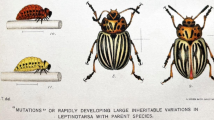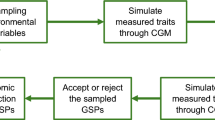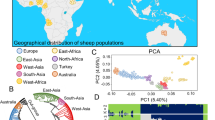Abstract
Dominant markers have been commonly used in mapping quantitative trait loci (QTLs) in outcrossing species, in which not much prior genome information is available. But the dominant nature of these markers may lead to reduced QTL mapping precision and power. A new statistical method is proposed to incorporate growth laws into a QTL mapping framework, under which the use of the efficiency of dominant markers can be increased. This new method can be used to identify specific QTLs affecting differentiation in growth trajectories, and further estimate the timing of a QTL to turn on, or turn off, affecting growth during the entire ontogeny of a species. Using this method based on dominant markers we have successfully mapped a QTL for stem height growth trajectories to a linkage group in a forest tree. The implications of this method for the understanding of the genetic architecture of growth using dominant markers are discussed.



Similar content being viewed by others
References
Atchley WR (1984) Ontogeny, timing of development, and genetic variance-covariance structure. Am Nat 123:519–540
Atchley WR, Zhu J (1997) Developmental quantitative genetics, conditional epigenetic variability and growth in mice. Genetics 147:765–776
Bertalanffy von L (1957) Quantitative laws for metabolism and growth. Quart Rev Biol 32:217–231
Box GEP, Cox DR (1964) An analysis of transformations. J Roy Stat Soc, pp 211-252
Carroll RJ, Ruppert D (1984) Power-transformations when fitting theoretical models to data. J Am Stat Assoc 79:321–328
Cheverud JM, Routman EJ, Duarte FAM, van Swinderen B, Cothran K, Perel C (1996) Quantitative trait loci for murine growth. Genetics 142:1305–1319
Davidian M, Giltinan DM (1995) Nonlinear models for repeated measurement data. Chapman and Hall, London
Dempster AP, Laird NM, Rubin DB (1977) Maximum likelihood from incomplete data via EM algorithm. J Roy Stat Sco Ser B 39:1–38
Doerge RW, Churchill GA (1996) Permutation tests for multiple loci affecting a quantitative character. Genetics 142:285–294
Gessler DDG, Xu S (1999) Multipoint genetic mapping of quantitative trait loci with dominant markers in outbred populations. Genetica 105:281–291
Jansen RC (1996) A general Monte Carlo method for mapping multiple quantitative trait loci. Genetics 142:305–311
Kirkpatrick M, Heckman N (1989) A quantitative genetic model for growth, shape, reaction norms, and other infinite-dimensional characters. J Math Biol 27:429–450
Kirkpatrick M, Lofsvold D, Bulmer M (1990) Analysis of the inheritance, selection and evolution of growth trajectories. Genetics 124:979–993
Kirkpatrick M, Hill WG, Thompson R (1994) Estimating the covariance structure of traits during growth and aging, illustrated with lactation in dairy cattle. Genet Res 64:57–69
Korol AB, Ronin YI, Itskovich AM, Peng J, Nevo E (2001) Enhanced efficiency of quantitative trait loci mapping analysis based on multivariate complexes of quantitative traits. Genetics 157:1789–1803
Lander ES, Botstein D (1989) Mapping Mendelian factors underlying quantitative traits using RFLP linkage maps. Genetics 121:185–199
Lander ES, Green P (1987) Construction of multilocus genetic linkage maps in human. Proc Natl Acad Sci USA 84:2363–2367
Lou X-Y, Casella G, Littell RC, Yang MCK, Johnson JA, Wu RL (2003) A haplotype-based algorithm for multilocus linkage-disequilibrium mapping of quantitative trait loci with epistasis. Genetics 163:1533–1548
Lund MS, Sorensen P, Madsen P (2002) Linkage analysis in longitudinal data using random regression. 7th World Congress on Genetics Applied to Livestock Production, August 19–23 2002, Montpellier, France
Ma CX, Casella G, Wu RL (2002) Functional mapping of quantitative trait loci underlying the character process: a theoretical framework. Genetics 161:1751–1762
Mackay TFC (2001) Quantitative trait loci in Drosophila. Nature Rev Genet 2:11–20
Maliepaard C, Alston FH, van Arkel G, et al: (1998) Aligning male and female linkage maps of apple (Malus pumila Mill.) using multi-allelic markers. Theor Appl Genet 97:60–73
Nunez-Anton V (1997) Longitudinal data analysis: non-stationary error structures and antedependent models. Appl Stoch Models Data Anal 13:279–287
Nunez-Anton V, Zimmerman DL (2000) Modeling nonstationary longitudinal data. Biometrics 56:699–705
Pletcher SD, Geyer CJ (1999) The genetic analysis of age-dependent traits: modeling the character process. Genetics 153:825–835
Ritter E, Gebhardt C, Salamini F (1990) Estimation of recombination frequencies and construction of RFLP linkage maps in plants from crosses between heterozygous parents. Genetics 125:645–654
Vaughn TT, Pletscher LS, Peripato A, King-Ellison K, Adams E, Erikson C, Cheverud JM (1999) Mapping quantitative trait loci for murine growth: a closer look at genetic architecture. Genet Res 74:313–322
Verbeke G, Molenberghs G (2000) Linear mixed models for longitudinal data. Springer, Berlin Heidelberg New York
West GB, Brown JH, Enquist BJ (2001) A general model for ontogenetic growth. Nature 413:628–631
Wu RL, Ma C-X, Painter I, Zeng Z-B (2002a) Simultaneous maximum-likelihood estimation of linkages and linkage phases over a heterogeneous genome. Theor Pop Biol 61:349–363
Wu RL, Ma C-X, Casella G (2002b) Joint linkage and linkage-disequilibrium mapping of quantitative trait loci in natural populations. Genetics 160:779–792
Xie C, Xu S (1999) Mapping quantitative trait loci with dominant markers in four-way crosses. Theor Appl Genet 98:1014–1021
Yin TM, Zhang XY, Huang MR, Wang MX, Zhuge Q, Tu SM, Zhu L-H, Wu RL (2002) The molecular linkage maps of the Populus genome. Genome 45:541–555
Young WP, Wheeler PA, Coryell VH, Keim P, Thorgaard GH (1998) A detailed linkage map of rainbow trout produced using doubled haploids. Genetics 148:839–850
Acknowledgements
We thank two anonymous referees for their constructive comments on this manuscript. This work is supported by an Outstanding Young Investigator Award (30128017) of the National Natural Science Foundation of China, a University of Florida Research Opportunity Fund (02050259), and a University of South Florida Biodefense grant (7222061-12) to R. W. The publication of this manuscript was approved as Journal Series No. R-09204 by the Florida Agricultural Experiment Station.
Author information
Authors and Affiliations
Corresponding author
Additional information
Communicated by F. Salamini
Rights and permissions
About this article
Cite this article
Ma, CX., Lin, M., Littell, R.C. et al. A likelihood approach for mapping growth trajectories using dominant markers in a phase-unknown full-sib family. Theor Appl Genet 108, 699–705 (2004). https://doi.org/10.1007/s00122-003-1484-9
Received:
Accepted:
Published:
Issue Date:
DOI: https://doi.org/10.1007/s00122-003-1484-9




